Home office: safety tips for the new normal

This virus not only confronts many companies with enormous economic challenges, it also brings new tasks for IT security.
In order to minimize the risk of infection and to take into account the exit restrictions, closed schools and childcare facilities, many companies have started to send their employees to their home offices.
This shift has increased remote activities, such as teleworking. Teleworking furthers the reliance on email for communication, thus creating perfect conditions for email fraud schemes.
How scammers operate
Malicious email messages that might ask you to open an attachment supposedly containing pertinent information regarding the Coronavirus are likely to download malicious software onto your device as soon as you click on the attachment or embedded link.
This software could allow cybercriminals to take control of your computer, log your keystrokes or access your personal information and financial data, which could lead to identity theft.
How to recognize them
The emails sent usually:
- Look identical to messages from a reputable organisation
- Sound urgent or try to spread fear
- Claim to enclose important information or breaking news
- Ask you to download or click on attachments and links

How to Protect against them
1) Do not open unsolicited email from people unfamiliar to you or click on suspicious attachments.
2) Never supply any personal or financial information and passwords to anyone via email.
3) Check the email address. Check the sender’s name, email address and whether the email domain matches the organisation that the sender claims to be from. If not, it is probably a phishing attempt.
4) Protect your devices. Install anti-spam, anti-spyware and anti-virus software and make sure they are always up to date.
